March 17 - Saint Patrick's Day | Learning with CJ #5
Some people are curious about the St. Patrick's Day. Green attires, shamrock leaves and more! We heard that a lot of times without knowing the reason behind celebrating it. I myself wanted to share this information I gathered from internet about this day the "St. Patrick's Day."
What is Saint Patrick's Day
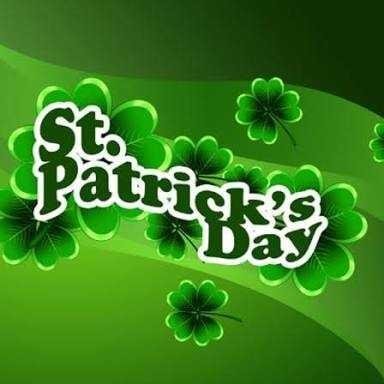
Saint Patrick's Day, or the Feast of Saint Patrick is a cultural and religious celebration held every March 17 today the traditional death date of Saint Patrick the foremost patron saint of Ireland.
Saint Patrick's Day was made an official Christian feast day in the early 17th century and is observed by the Catholic Church, the Anglican Communion (especially the Church of Ireland),the Eastern Orthodox Church, and the Lutheran Church. The day commemorates Saint Patrick and the arrival of Christianity in Ireland, and celebrates the heritage and culture of the Irish in general. Celebrations generally involve public parades and festivals, cèilidhs, and the wearing of green attire or shamrocks. Christians who belong to liturgical denominations also attend church services and historically the Lentenrestrictions on eating and drinking alcoholwere lifted for the day, which has encouraged and propagated the holiday's tradition of alcohol consumption.
Saint Patrick's Day is a public holiday in the Republic of Ireland, Northern Ireland, the Canadian province of Newfoundland and Labrador (for provincial government employees), and the British Overseas Territory of Montserrat. It is also widely celebrated by the Irish diaspora around the world, especially in the United Kingdom, Canada, United States, Brazil, Argentina, Australia and New Zealand. Saint Patrick's Day is celebrated in more countries than any other national festival. Modern celebrations have been greatly influenced by those of the Irish diaspora, particularly those that developed in North America. In recent years, there has been criticism of Saint Patrick's Day celebrations for having become too commercialised and for fostering negative stereotypes of the Irish people.
Who is Patrick?
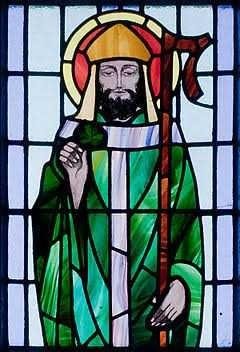
Patrick was a 5th-century Romano-British Christian missionary and bishop in Ireland. Much of what is known about Saint Patrick comes from the Declaration, which was allegedly written by Patrick himself. It is believed that he was born in Roman Britain in the fourth century, into a wealthy Romano-British family. His father was a deacon and his grandfather was a priest in the Christian church. According to the Declaration, at the age of sixteen, he was kidnapped by Irish raiders and taken as a slave to Gaelic Ireland. It says that he spent six years there working as a shepherd and that during this time he "found God". The Declaration says that God told Patrick to flee to the coast, where a ship would be waiting to take him home. After making his way home, Patrick went on to become a priest.
According to tradition, Patrick returned to Ireland to convert the pagan Irish to Christianity. The Declaration says that he spent many years evangelising in the northern half of Ireland and converted "thousands". Patrick's efforts against the druids were eventually turned into an allegory in which he drove "snakes" out of Ireland (Ireland never had any snakes).
Tradition holds that he died on 17 March and was buried at Downpatrick. Over the following centuries, many legends grew up around Patrick and he became Ireland's foremost saint.
Today's St Patrick's Day celebrations have been greatly influenced by those that developed among the Irish diaspora, especially in North America. Until the late 20th century, St Patrick's Day was often a bigger celebration among the diaspora than it was in Ireland.
Traditions
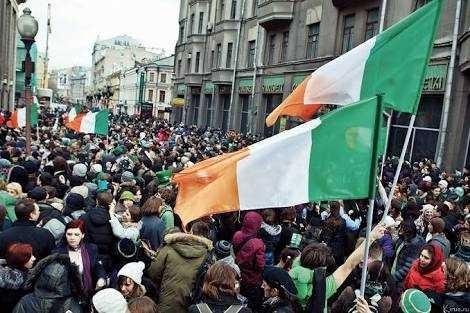
Celebrations generally involve public parades and festivals, Irish traditional music sessions (céilithe), and the wearing of green attire or shamrocks. There are also formal gatherings such as banquets and dances, although these were more common in the past. St Patrick's Day parades began in North America in the 18th century but did not spread to Ireland until the 20th century. The participants generally include marching bands, the military, fire brigades, cultural organisations, charitable organisations, voluntary associations, youth groups, fraternities, and so on. However, over time, many of the parades have become more akin to a carnival. More effort is made to use the Irish language, especially in Ireland, where the week of St Patrick's Day is "Irish language week". Recently, famous landmarks have been lit up in green on St Patrick's Day.
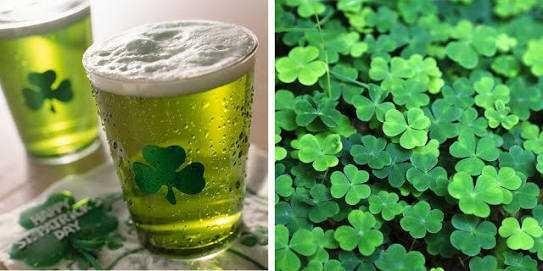
Christians may also attend church services, and the Lenten restrictions on eating and drinking alcohol are lifted for the day. Perhaps because of this, drinking alcohol – particularly Irish whiskey, beer, or cider – has become an integral part of the celebrations. The St Patrick's Day custom of "drowning the shamrock" or "wetting the shamrock" was historically popular, especially in Ireland. At the end of the celebrations, a shamrock is put into the bottom of a cup, which is then filled with whiskey, beer, or cider. It is then drunk as a toast to St Patrick, Ireland, or those present. The shamrock would either be swallowed with the drink or taken out and tossed over the shoulder for good luck.
Wearing green
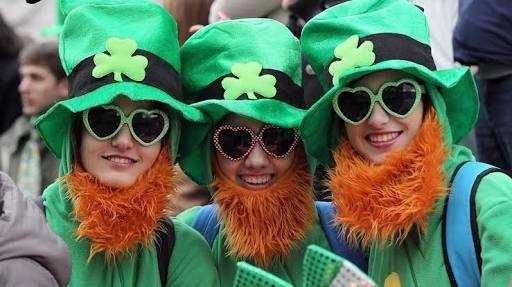
On St Patrick's Day, it is customary to wear** shamrocks, green clothing or green accessories**. St Patrick is said to have used the shamrock, a three-leaved plant, to explain the Holy Trinity to the pagan Irish. This story first appears in writing in 1726, though it may be older. In pagan Ireland, three was a significant number and the Irish had many triple deities, a fact that may have aided St Patrick in his evangelisation efforts.Patricia Monaghan says there is no evidence that the shamrock was sacred to the pagan Irish. However, Jack Santino speculates that it may have represented the regenerative powers of nature, and was recast in a Christian context—icons of St Patrick often depict the saint "with a cross in one hand and a sprig of shamrocks in the other". Roger Homan writes, "We can perhaps see St Patrick drawing upon the visual concept of the triskele when he uses the shamrock to explain the Trinity".
The first association of the colour green with Ireland is from the 11th century pseudo-historical book Lebor Gabála Érenn (The Book of the Taking of Ireland), which forms part of the Mythological Cycle in Irish Mythology and describes the story of Goídel Glas who is credited as the eponymous ancestor of the Gaels and creator of the Goidelic languages(Irish, Scottish Gaelic, Manx). In the story Goídel Glas, who was the son of Scotaand Niul, was bitten by a snake and was saved from death by Moses placing his staff on the snakebite. As a reminder of the incident he would retain a green mark that would stay with him and he would lead his people to a land that would be free of snakes. This is emphasized in his name Goídel which was anglicised to the word Gaelic and Glas which is the Irish word for green. Another story from the Lebor Gabála Érenn written after the adventures of Goídel Glas refers to Íth climbing the tower (in reference to the Tower of Hercules) his father Breogán builds in Brigantia (modern day Corunna in Galicia, Spain) on a winters day and is so captivated by the sight of a beautiful green island in the distance that he must set sail immediately. This story also introduces three national personifications of Ireland, Banba, Fódla and Ériu. The Colour green was further associated with Ireland from the 1640s, when the green harp flag was used by the Irish Catholic Confederation. Green ribbons and shamrocks have been worn on St Patrick's Day since at least the 1680s. The Friendly Brothers of St Patrick, an Irish fraternity founded in about 1750, adopted green as its colour. However, when the Order of St. Patrick—an Anglo-Irish chivalric order—was founded in 1783 it adopted blue as its colour, which led to blue being associated with St Patrick. During the 1790s, green would become associated with Irish nationalism, due to its use by the United Irishmen. This was a republican organisation—led mostly by Protestants but with many Catholic members—who launched a rebellion in 1798 against British rule. The phrase "wearing of the green" comes from a song of the same name, which laments United Irishmen supporters being persecuted for wearing green. The late nineteenth and early twentieth centuries, seen the re-emergence of Irish cultural symbols, such as the Irish Language, Irish mythology, and the colour green, through the Gaelic Revival and the Irish Literary Revival which served to stir Irish nationalist sentiment. The influence of green was more prominently observable in the flagsof the 1916 Easter Rising such as the Sunburst Flag, the Starry Plough Banner, and the Proclamation Flag of the Irish Republicwhich was flown over the General Post Office, Dublin together with the Irish Tricolour. Throughout these centuries, the colour green and its association with St Patrick's Day grew.
The wearing of the 'St Patrick's Day Cross' was also a popular custom in Ireland until the early 20th century. These were a Celtic Christian cross made of paper that was "covered with silk or ribbon of different colours, and a bunch or rosette of green silk in the centre".
Luck o' the Leprechaun
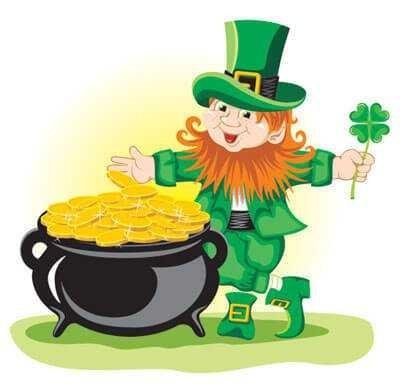
The St. Patrick's Day leprechaun is an Irish fairy. Most fairies are delicate and pretty, but this one sure isn't! He looks like an old man and stands at around two feet tall. Dressed in head-to-toe green, he has a pair of pointy ears and carries a big stick called a shillelagh, which he uses to scare anyone who tries to steal his gold. He prefers to be alone and spends his time either making shoes or searching for gold.
"Luck is believing that you're lucky."
Happy St. Patrick's Day steemians!
Learning with CJ series:
#1 Abstract Art
#3 2018 Pyeongchang Paralympics
Greetings,
@carlitojoshua
Hello.
You may to redact your post for the case of
https://staging.busy.org/saint-patrick/@steemitboard/steemitboard-catch-the-saint-patrick-s-day-award
(to get an award for the St. Patrick's Day!
Good Luck!
You may follow me and up my post as for support (no matter of what % of up)
I try to share this SteemitBoard action between Russian Speaking comminuty of Steemit
https://staging.busy.org/@shenan/nagrada-ot-doski-pochyota-den-svyatogo-patrika-usloviya-do-konca-17-marta
Thanks for the information😁☺
Well what an informative blog post you have here @carlitojoshua. I didn't know today's Saint Patrick's Day if I hadn't read your post 😅
Hehe thank you ate @adeline24 😉